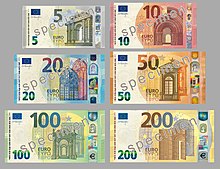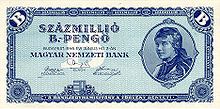Denomination (currency)
The denomination is the denomination of a currency in circulation carried out by a state act of sovereignty , which is visible through different nominal values on banknotes and coins .
General
The government of a state decides on the denominations of a currency as part of its currency policy . The marketability of a currency also depends on the nominal value of its banknotes and coins. During the French era , for example, when a new currency was introduced in the Rhineland, a ban on low denominations was envisaged, which would have made it impossible to circulate in retail trade. In countries with hyperinflation , it is again evident that, due to the galloping price level, ever higher nominal values are required in order to be able to pay purchase prices with a few banknotes. If the central bank does not adapt to this by issuing higher nominal values, the speed of circulation of money increases automatically , which leads to greater wear and tear on the banknotes, but above all further promotes inflation . In this situation, coins with even smaller denominations than banknotes lose their function as means of payment almost completely.
Euro
Art. 2 Regulation (EC) no. 974/98 of 3 May 1998 on the introduction of the euro since 1 January 1999 the currency of the participating EU Member States of the euro . The currency unit is one euro, one euro is divided into 100 cents. The lowest denomination of the euro is 1 cent , the highest is a 200 euro banknote . The introduction of the euro was merely a currency changeover , i.e. the conversion of all amounts of money at the fixed exchange rate . All assets and liabilities , all receivables and payables were converted at the same exchange rate.
Legal issues
The European Central Bank (ECB) has the exclusive right to authorize the issue of euro banknotes within the Union; the ECB and the national central banks are entitled to issue these banknotes ( Art. 128 (1) TFEU ). In Germany, the issuing of notes for the Deutsche Bundesbank is regulated in Section 14 (1) BBankG . According to this, the Deutsche Bundesbank has to make public the denominations and the distinguishing features of the banknotes it has issued.
Demarcation
Denomination and denomination are sometimes considered synonyms, but they are not. The denomination does have to do with currencies, but the selection is a particular currency in contracts or in the emission of effects .
Individual evidence
- ↑ Hans Otto Schötz, Der Kampf um die Mark 1923/24 , 1987, p. 76
- ↑ BT-Drs. 13/10251 of March 27, 1998, Second Report of the European Economic and Monetary Union Task Force of the Federal Ministry of Finance and the Federal Ministries (AS WWU) , p. 5

